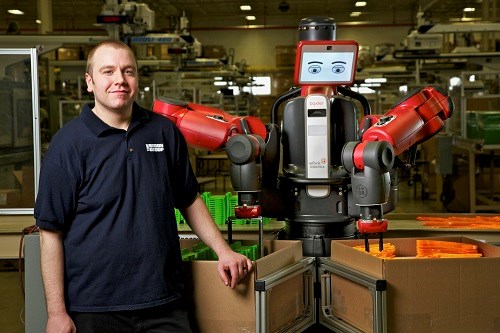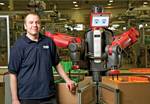Safety Guidance Coming for ‘Collaborative’ Robots
Safety standards coming for robots designed to work alongside humans.
So-called “collaborative” robots are designed to work safely alongside humans without requiring isolation behind a safety cage. Perhaps the best-known example is the Baxter robot from , Boston. For safety, it incorporates 360° sonar and front-facing vision system to detect human presence and perform its tasks. It can “see” in 3D, sensing height and distance. And its “servo-elastic” control prevents harmful collisions: If one of its two arms meets resistance force of less than 1 lb, it will stop, and then continue on its path once the resistance is removed (for more details, see Nov. ’13 Close Up).

The Baxter robot at the Rodon Group.
In order to ensure safe operation of all such devices, the , Ann Arbor, Mich., is working with the International Organization for Standardization (ISO) committee for Industrial Robot Safety in developing Technical Specification TS 15066 for guidance on safe deployment of collaborative robots. (It will expand on the brief discussion in ANSI/RIA R15.06-2012, Parts 1 & 2.) A key provision of TS 15066 will be threshold power and force values and guidance for situations where contact between humans and collaborative robots can occur. Still a work in progress, the final specification is expected to be published late this year or in early 2015. In the meantime, The German machinery manufacturers’ organization VDMA has prepared a position paper, “Safety in Human-Robot Collaboration,” that summarizes the relevant ISO standards and other related guidance on collaborative robots. The PDF is available .
Related Content
-
Conair: Going All In on AI
Conveying with Optimizer, Conair’s new AI-based conveying technology stands to be a true game changer for plastics processors.
-
AI: The Next Big Thing in Plastics Processing
Discover how artifical intelligence is revolutionizing plastics processing. Hear from industry experts on the future impact of AI on your operations and envision a fully interconnected plant.
-
What to Look for in High-Speed Automation for Pipette Production
Automation is a must-have for molders of pipettes. Make sure your supplier provides assurances of throughput and output, manpower utilization, floor space consumption and payback period.






